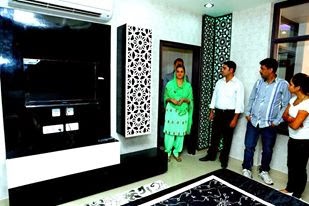It is but a fact that one half of all greenhouse gas emissions are contributed by buildings that are not green. When we speak about green buildings, it is all about saving the environment, saving energy, creating sustainable design projects, and improving the productivity and livability of the dwellers. Maximizing of both economic and environmental performance can be achieved through adoption of green building strategies right from design to construction of a building, also encompassing renovation and deconstruction. Thanks to the development of home automation technology that has helped in the development of greener structures, facilitating efficient use of energy, water, and other resources besides protecting occupants’ health and reducing environmental degradation. Yes, green buildings are the future!
Top five benefits of green buildings:
1. Energy efficiency: Right from the construction stage to occupancy, green buildings consume less energy. Installation of high-performance windows including extra insulation in walls, ceilings, and floors are part of the green strategy. Occupants save big money on electricity bills with energy consumption varying in terms of installation of automation controls and energy efficient devices
2. Water efficiency: Recycling of rainwater and grey water for irrigation, urinal flow, and other external washing purposes is an integral constituent of a green building. This helps in preservation of potable water. Another objective of a sustainable building is protecting the quality of water and reducing water consumption
3. Designing a green building is directed towards the comfort, well-being, and productivity of dwellers ensuring superlativeness in indoor air (reduction of volatile organic compounds and control of moisture accumulation), lighting (careful blend of electrical lights and daylight), and thermal quality. In short, it is the enhancement of indoor ambience and environmental quality
4. Easy maintenance and low operating costs lead to high value appreciation of green building properties. While productivity of occupants increases, a stable health is equally ensured. Overall operating costs of a green building, whether it is used for residential or commercial purposes, is significantly reduced
5. A green building emits negligible greenhouse gas. It contributes towards creation of a sustainable earth through reduced energy consumption, thus conserving the earth’s natural resources. Occupants not only save money but also help shape a greener earth. Reduction of waste besides enhancement and protection of ecosystems are facilitated by green buildings
Top five systems / devices used in green buildings:
1. Automation systems (PLC) / SCADA: Controlling and monitoring of mechanical functions including automated electrical activities in a green building is facilitated by automation systems. While PLC is suitable for small buildings, larger areas require the SCADA. The PLC / SCADA is connected to various home systems connected via wires and cables and linked to a user interface through wi-fi
2. Security devices: Installation of security devices in green buildings ensures a secured premise, indoors and outdoors. Home owners generally install a comprehensive range of devices, starting from CCTV cameras, DVRs, alarm systems / siren horns, glass break sensors, biometric door locks to smoke detectors, gas leak detectors, access control systems, motion detectors, digital keypads, and more
3. LED lights: The most energy efficient lighting systems installed in green buildings are LED lights. They help save 80 percent of energy compared to other lights. LED lights are highly durable, environment-friendly, and shock-resistant and they operate approximately for 100,000 hours. Though costlier than conventional lights, they help occupants save big in the long run.
4. 5-star rated HVAC and electronic appliances: Installation of 5-star rated HVAC and electronic appliances is integral to green buildings for optimum utilization of energy. They may cost high initially, but occupants save big on electricity bills every month, thus quickly getting returns in the long run.
5. Motion / occupancy sensors: Installation of motion / occupancy sensors connected to lights and HVAC helps in reduced energy consumption further. Lights and HVAC turn on and off automatically based on occupancy or motion thus facilitating occupants save energy significantly. Automation of green buildings is the solution!























